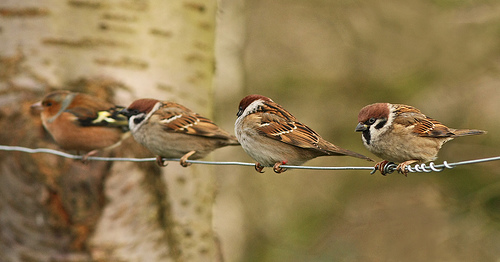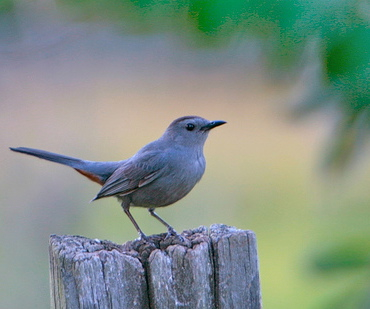 Tree sparrows have seen large declines in western Europe, in part due to changes in farming practices.Photo: Nutmeg66Call it the bird tax — or rather, the amount of food that farmers need to set aside in order to get birds to stick around and stop dying. Farmers don’t historically have an awesome relationship with birds [PDF], but in recent years, they’ve actually been paid to scatter grain around their land after the harvest, since a lack of seed resources in winter is thought to be one of the reasons for birds’ dramatic decline. Some of the seeds farmers spread around the edge of their fields are also attractive to pollinating insects, which is also thought to be good, since birds like to eat insects too.
Tree sparrows have seen large declines in western Europe, in part due to changes in farming practices.Photo: Nutmeg66Call it the bird tax — or rather, the amount of food that farmers need to set aside in order to get birds to stick around and stop dying. Farmers don’t historically have an awesome relationship with birds [PDF], but in recent years, they’ve actually been paid to scatter grain around their land after the harvest, since a lack of seed resources in winter is thought to be one of the reasons for birds’ dramatic decline. Some of the seeds farmers spread around the edge of their fields are also attractive to pollinating insects, which is also thought to be good, since birds like to eat insects too.
Why put so much effort into attracting birds to farms? Well, the steady decline of most birds in the world and the increase of the human population are related — and, idealism aside, there’s only so much that wilderness conservation can do to alter that trajectory. And so a fascinating and pragmatic branch of science is developing. It asks the question: Is there a way to feed wildlife, while feeding ourselves?
One recent study took a close look at this question. A team of four scientists in the United Kingdom spent a year collecting dirt from all over an organic farm near Bristol, which grew mostly clover, oats, wheat, and barley. Their goal? To determine just how much food a farm that grows crops to feed humans also provides for wildlife. What they found: that weeds play a surprisingly important role in attracting and feeding birds — in fact, they might be key to farm biodiversity.
The soil sampling was a complicated operation. “You know you can get those leaf blowers?” says Darren Evans, the lead researcher on the project, during a recent phone interview. “We modified one so that it sucked rather than blew.” The group sampled 250 spots around the farm and, after drying and sifting the dirt collected, found themselves with 171,000 seeds. “We counted and identified every single one,” Evans adds, sounding a bit weary. “It took a long time.”
The team managed to identify 156,000 seeds from about 125 different plants. They tallied the energy content of each seed species and estimated that the 300-acre farm contained 33 metric tons of biomass and 560 gigajoules of energy that could be ingested by local wildlife — most of it in the form of seeds and berries.
However, most of the seeds also happened to be from plants that the farmer in question never had any intention of growing. The two most energy-rich sites on the farm were areas where crops hadn’t been planted, either. What this meant was that most of the high-quality bird food on the ground was coming from weeds.
This is not a huge surprise. Most plants in the world exist because someone likes to eat them. Our favorite crops have spread all over the face of the earth because we like them enough to plant them, water them, and interfere in their sex lives. And some believe weeds spread far and wide because they provide food to animals and insects, who carry their seeds with them on to their next destination.
When we view weeds as important to wildlife, however, it creates a complicated scenario for biodiversity researchers. “Weeds are the farmer’s number one enemy,” says Evans. “They know weeds will choke their plants and cause all sorts of problems.”
But, he adds, “over 100 species depend on the seeds they produce.” More research is necessary, he says, before farmers and scientists will know exactly how to balance both needs. “There are trade-offs going on, basically. A farmer is going to have to decide: How many weeds am I going to have before it becomes a problem for our crops?”
But the findings had an encouraging side as well. If further research bears this discovery out, relatively minor changes to farming incentives could have big effects. If farmers were given incentives to stop cutting or spraying the weeds growing around their hedgerows, in their tractor yards, and in other areas around the margins of their farms, it could have a disproportionately large effect on food for wildlife. And hedgerows — wild borders of shrubs and trees left around farmland as a living fence or as a boundary marker, once ripped up so that farm equipment could turn around more easily — are now historically protected in England. And because of their reputation as valuable habitat for wild birds and pollinators [PDF], they may now be further encouraged. Hedgerows are also returning in California’s Central Valley, where populations of wild pollinators are also in rapid decline.
And there’s another potential benefit. Of the 300-plus animal species who feed on the seeds recorded on the test farm in the U.K., 53 were birds and 10 were mammals. The rest were arthropods — a group that includes several insects whose presence would be alluring to farmers, such as pest-controlling wasps. The wasps are drawn to the seeds of common weeds like yarrow and Queen Anne’s lace, but also help control aphids. If connections like this were made clearer, farmers might have more of an incentive to tolerate weeds — or at least, certain kinds.
Ninety-eight percent of the land in the U.K. is managed by humans in one way or other. Seventy-seven percent of the country is farmland, and that is where most of England’s biodiversity is found. And so England’s remaining wilderness depends largely on how the nation decides to grow its food.
But the U.K. — and the European Union, and the rest of the world — is also thinking about how agriculture will change in the years ahead, as global climate change continues to add even more uncertainty into the business of farming. Weeds, in particular, are a source of hope and anxiety, since they are adapting to climate change more quickly than domesticated plants.
The next step, says Evans, would be to replicate this sort of research across a variety of farms — around Europe and across the world. “We know so much about the natural history of our countryside but almost nothing about how the species interact. They’re like engine parts; they’re all components. To find this — it’s an exciting time.”

